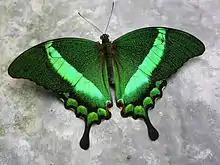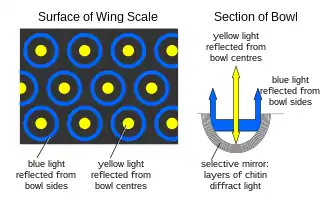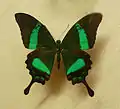Papilio palinurus
Papilio palinurus, the emerald swallowtail, emerald peacock, or green-banded peacock, is a butterfly of the genus Papilio of the family Papilionidae. It is native to Southeast Asia, but is regularly kept in butterfly houses around the world.
| Papilio palinurus | |
|---|---|
 | |
| Scientific classification | |
| Domain: | Eukaryota |
| Kingdom: | Animalia |
| Phylum: | Arthropoda |
| Class: | Insecta |
| Order: | Lepidoptera |
| Family: | Papilionidae |
| Genus: | Papilio |
| Species: | P. palinurus |
| Binomial name | |
| Papilio palinurus Fabricius, 1787 | |
Subspecies
There are several subspecies (from Burma, Borneo, Indonesia, Nias and the Philippines).
- P. p. palinurus – Burma, Malaysia Borneo
- P. p. auffenbergi Späth, 1992 – Simeulue, Indonesia[1]
- P. p. nymphodorus (Fruhstorfer) – Island of Basilan
- P. p. adventus (Fruhstorfer) – Island of Nias
- P. p. daedalus (C. & R. Felder, 1861) – Philippines
- P. p. angustatus (Staudinger, 1888) – Island of Palawan, Philippines
Etymology
The genus name Papilio comes from the Latin word papilio meaning butterfly. The species name palinurus derives from Palinurus, the name of the pilot of Aeneas's boat in Virgil's Aeneid.
Description
Papilio palinurus has a wingspan reaching about 8–10 centimetres (3.1–3.9 in). The dorsal sides of the wings are covered by a powder of green scales and the background vary from dark greenish to black, with broad bright emerald green metallic bands. The undersides are black with orange, white and blue spots along the edges of hindwings, that show extended tails at the end.
The flight of these butterflies is swift and quite fast. Caterpillars feed on plants of genus Euodia belonging to the Rutaceae, commonly known as the rue or citrus family.
Green by structural coloration

The iridescent green sheen of the bands of this butterfly is not produced by pigments, but is structural coloration produced by the microstructure of the wing scales. They refract the light and give rise to blue and yellow visible reflections, producing the perception of green color when additively mixed.[2][3][4]
Distribution
This species can be found primarily in Southeast Asia, particularly in Burma – Peninsular Malaysia, Sumatra, Borneo, Indonesia (Simeulue, Island of Nias), Philippines (Basilan, Palawan, Balabac, Cuyo, Busuanga, and Dumaran).
Habitat
Papilio palinurus lives in Asian primary forests.
Gallery
 Specimen from the Musée zoologique de la ville de Strasbourg
Specimen from the Musée zoologique de la ville de Strasbourg Can appear blue with certain lighting
Can appear blue with certain lighting.JPG.webp) Ventral view
Ventral view.JPG.webp) Underwing
Underwing
References
- Späth, Manfred (1992). "Zwei neue Taxa der Gattung Papilio Linnaeus 1758 aus Indonesia (Lepidoptera: Papilionidae)". Entomologische Zeitschrift. 102 (16): 289–304.
- Ball, Philip (May 2012). "Scientific American". Nature's Color Tricks. Vol. 306. pp. 74–79. doi:10.1038/scientificamerican0512-74. Retrieved April 23, 2012.
- Crne, Matija; Vivek Sharma, John Blair, Jung Ok Park, Christopher J. Summers, and Mohan Srinivasarao (2011). Biomimicry of optical microstructures of Papilio palinurus" EPL 93(January):1401-p1–p4 doi:10.1209/0295-5075/93/14001.
- Vukusic, P.; Sambles, J.R.; & Lawrence, C.R. (2000). "Structural Colour – Colour Mixing in Wing Scales of a Butterfly." Nature 404(6777):457 DOI:10.1038/35006561.
Further reading
- Erich Bauer and Thomas Frankenbach (1998). Schmetterlinge der Erde, Butterflies of the World Part I (1), Papilionidae Papilionidae I: Papilio, Subgenus Achillides, Bhutanitis, Teinopalpus. Edited by Erich Bauer and Thomas Frankenbach. Keltern: Goecke & Evers; Canterbury: Hillside Books ISBN 9783931374624
- Zipcodezoo
- Biolib
- Funet.fi